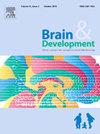结节性硬化症复合体:临床、遗传和7T-MRI神经成像结果
IF 1.3
4区 医学
Q4 CLINICAL NEUROLOGY
引用次数: 0
摘要
结节性硬化症(TSC)是一种由TSC1或TSC2基因的单等位致病变异引起的多系统疾病。神经病理学特征是皮层和皮层下结节的存在。癫痫病的发病率高达85%。目的探讨三组TSC患者(活动性癫痫、控制性癫痫和非癫痫)块茎的数量和位置与神经心理和遗传特征之间的关系。方法对30例经常规脑MRI检查的TSC患者进行脑7T-MRI研究。入组后对TSC1和TSC2进行分子分析。收集癫痫特征、神经心理表现以及7T-MRI显示的区域和总结节计数数据。结果活动性癫痫组脑额叶细胞计数明显高于对照组和非对照组(p = 0.008)。TSC2变异个体的总块茎数和额块茎数明显较高。与控制癫痫组相比,非癫痫组的总、言语和执行智商(IQ)得分显著高于控制癫痫组。注意缺陷/多动障碍(ADHD)在非癫痫组较少出现。结论TSC患者癫痫的严重程度与结节数有关,尤其是额叶结节数,并与TSC2有害变异有关。未来涉及更多患者的研究可能会为先进的成像癫痫生物标志物提供新的见解。本文章由计算机程序翻译,如有差异,请以英文原文为准。
Tuberous sclerosis complex: Clinical, genetic and 7T-MRI neuroimaging findings
Background
Tuberous sclerosis complex (TSC) is a multisystemic disorder caused by monoallelic pathogenic variants in TSC1 or TSC2 genes. Neuropathological hallmark is the presence of cortical and subcortical tubers, among others. Epilepsy affects up to 85 %.
Aims
The objective was to correlate the number and location of tubers with neuropsychological and genetic characteristics in three groups of TSC patients: with active epilepsy, controlled epilepsy and without epilepsy.
Methods
Brain 7T-MRI study was performed in 30 subjects with TSC who had previously done brain conventional MRI. Molecular analysis of TSC1 and TSC2 was conducted post-enrollment. Data on epilepsy characteristics, neuropsychological performance and regional and total tuber counts as seen on 7T-MRI, were collected.
Results
Tuber counting in the frontal lobe was significantly higher in the group with active epilepsy compared to the groups with controlled or without epilepsy (p = 0.008). Total and frontal tuber count were significantly higher in individuals with TSC2 variants. Total, verbal and executive intelligence quotient (IQ) scores were significantly higher in the group without epilepsy compared to the controlled epilepsy group. Attention deficit/hyperactivity disorder (ADHD) was less frequent in the group without epilepsy.
Conclusion
Severity of epilepsy in TSC correlates with the number of tubers, especially in the frontal lobe, and with the TSC2 deleterious variant. Future studies involving a larger number of patients may provide new insights into advanced imaging epilepsy biomarkers.
求助全文
通过发布文献求助,成功后即可免费获取论文全文。
去求助
来源期刊

Brain & Development
医学-临床神经学
CiteScore
3.60
自引率
0.00%
发文量
153
审稿时长
50 days
期刊介绍:
Brain and Development (ISSN 0387-7604) is the Official Journal of the Japanese Society of Child Neurology, and is aimed to promote clinical child neurology and developmental neuroscience.
The journal is devoted to publishing Review Articles, Full Length Original Papers, Case Reports and Letters to the Editor in the field of Child Neurology and related sciences. Proceedings of meetings, and professional announcements will be published at the Editor''s discretion. Letters concerning articles published in Brain and Development and other relevant issues are also welcome.
 求助内容:
求助内容: 应助结果提醒方式:
应助结果提醒方式:


